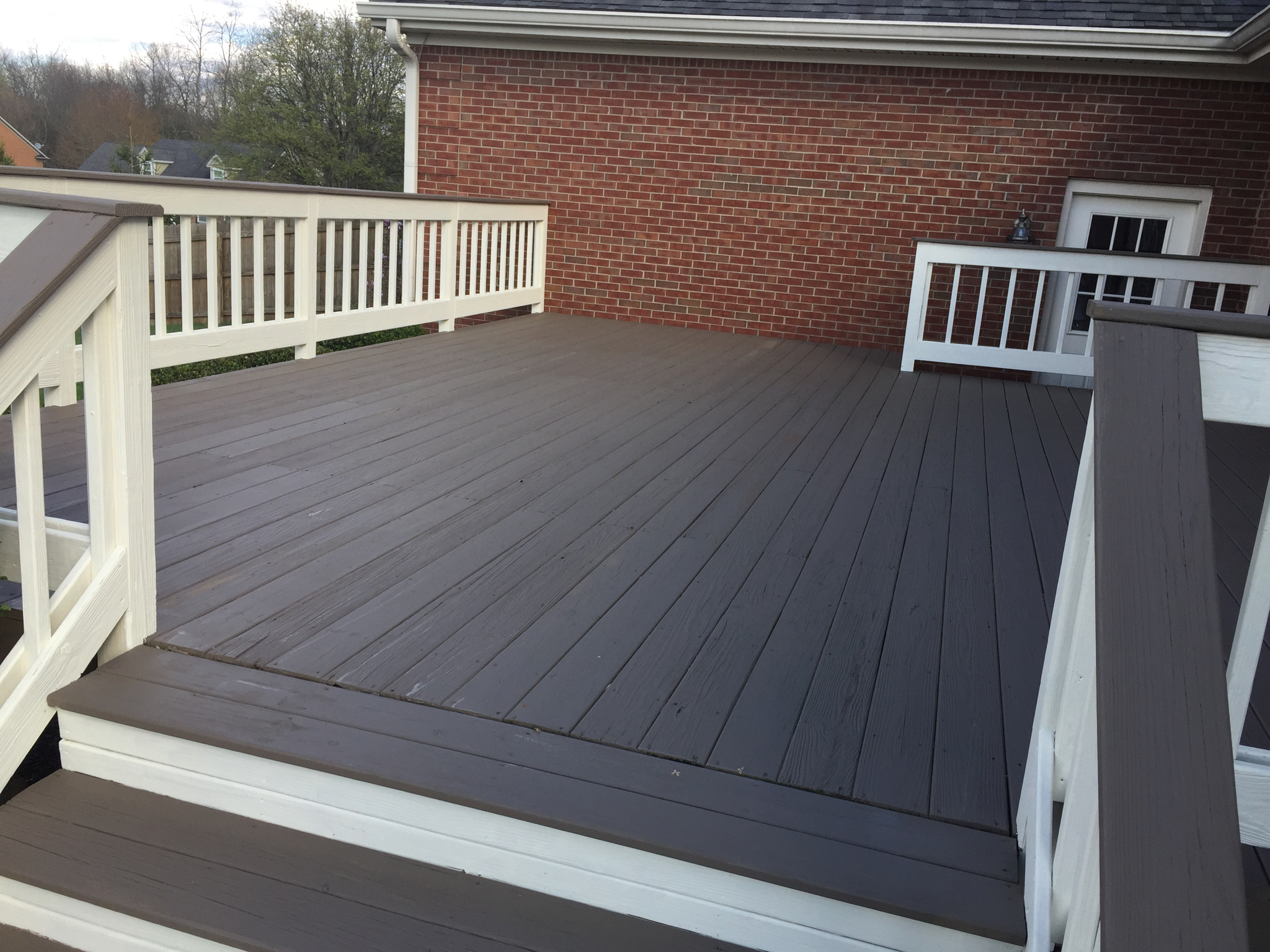Water-Based Stains for a Beautiful Deck: Eco-Friendly and Effective
Water-Based Stains for a Beautiful Deck: Eco-Friendly and Effective
Blog Article
A Comprehensive Overview to Various Kinds Of Deck Discoloration Techniques for Ultimate Defense and Aesthetics
In the realm of deck maintenance, the art of staining stands as a pivotal action towards both preserving the honesty of your outside space and boosting its visual allure. As we navigate through the complex world of deck discoloration methods, one begins to value the nuanced strategies that can make all the difference in between a mediocre coating and a perfect one.
Recognizing Different Sorts Of Spots
Various sorts of stains are generally utilized in the procedure of deck staining to attain different visual and protective impacts. Transparent spots are perfect for showcasing the all-natural grain of the wood while supplying minimal security versus UV rays and moisture. On the various other hand, semi-transparent stains use a balance between shade enhancement and security, permitting some wood grain to show via. For a more opaque coating that provides maximum defense versus the elements, strong discolorations are the preferred option. These discolorations come in a wide variety of shades and efficiently hide the timber grain.
Toners include a hint of color to the wood while providing marginal defense, making them ideal for more recent decks with less wear. Understanding the characteristics and advantages of each kind of discolor is important for achieving the desired appearance and longevity for your deck.
Selecting the Right Spot Color
When taking into consideration the aesthetics of your deck discoloration job, the option of stain shade plays a critical function in enhancing the safety high qualities of the selected tarnish type (Water-Based Stains). The color you pick can dramatically affect the overall appearance of your deck, as well as its capacity to stand up to the elements with time
When choosing a tarnish color, it's necessary to take into consideration the existing color design of your home's exterior. Harmonizing the deck discolor with the overall visual of your residential property can create a visually attractive and cohesive outside space. Furthermore, the shade of your deck discolor can affect the temperature of the deck surface area; darker colors have a tendency to soak up more warmth, while lighter colors show sunlight and remain cooler.
Furthermore, the sort of timber you are tarnishing will certainly also affect exactly how the discolor shade appears. Different timber species can communicate with the tarnish in various methods, possibly modifying the final color. It's suggested to test the discolor on a little, low-profile area of the deck to guarantee the shade ends up as desired before waging the whole task.
Preparing Your Deck for Discoloration
To ensure a resilient and effective deck discoloration task, comprehensive preparation of the deck surface area is crucial. Begin by cleaning the deck thoroughly to remove dirt, gunk, mildew, and any type of old tarnish or end up. Make use of a deck cleaner or a combination of water and cleaning agent along with a stiff brush or pressure washer to scrub the surface area tidy. After cleansing, permit the deck to completely dry entirely prior to proceeding to the following action.
Examine the deck for any damaged or rotten boards that require to be changed. Hammer down any type of protruding nails and sand any harsh areas to guarantee a smooth surface for discoloration. Inspect for any loosened barriers or steps that might require tightening or repair.
As index soon as the deck is tidy, dry, and in excellent repair work, consider using a wood brightener to bring back the deck's natural shade and open the wood pores for far better stain penetration. Finally, shield any type of nearby plants, furnishings, or surface areas with plastic sheet prior to waging the discoloration procedure. Proper preparation is vital to achieving a professional-looking surface and taking full advantage of the long life of your deck stain.
Applying Discoloration With Various Methods
For a expert and perfect coating, the method of applying discolor plays a crucial role in improving the look and resilience of your deck. There are a number of strategies you can make use of to ensure an efficient application of discolor.
Cleaning is a traditional method that enables accuracy and control over the quantity of discolor used. It is excellent for intricate areas and reaching between deck boards (Water-Based Stains). Rolling is a quicker alternative, covering bigger surface efficiently. Back-brushing after rolling is advised to also out the tarnish and function it right into the timber for much better infiltration.
Spraying is an additional preferred strategy, using speed and ease of application, especially for huge deck locations. It is essential to utilize a top notch sprayer and bear in mind overspray. Pad applicators supply a smooth and even finish and appropriate for both vertical and straight surfaces. Whichever technique you pick, making certain appropriate preparation and adhering to maker guidelines will assist achieve a beautiful and durable stain coating on your deck.

Preserving and Re-staining Your Deck
Proper maintenance and prompt re-staining are vital for maintaining the elegance and durability of your deck. Routine maintenance jobs consist of sweeping off particles, cleansing with a deck cleaner, and checking for any type of signs of wear or damages. Attending to issues promptly can protect against a lot more considerable problems in the future. When it involves re-staining your deck, the frequency depends on numerous elements such as the kind of discolor used, the environment in your area, and just how much damage your deck experiences. Normally, it is recommended to re-stain your deck every 2-4 years to keep its protection and aesthetics.
Prior to re-staining, guarantee the deck is tidy, completely dry, and free of any previous discolor deposit. Pick a high-quality tarnish that fits your deck's product and offers the desired level of security.
Verdict
To conclude, understanding the different kinds of deck stains, choosing the best color, correctly preparing the deck, applying stain with various techniques, and re-staining the deck and maintaining are essential steps for ultimate defense and aesthetics. By complying with these steps, you can guarantee that your deck remains in top problem for several years ahead.
Additionally, the color of your deck tarnish can affect the temperature of the deck surface; darker shades have a tendency to official source take in more warmth, while lighter colors reflect sunshine and remain cooler.
It's recommended to test the tarnish on you could try this out a little, unnoticeable location of the deck to make sure the color transforms out as preferred before continuing with the whole project.

Report this page